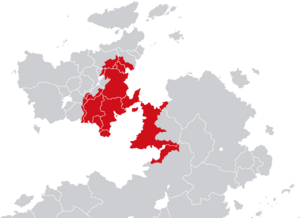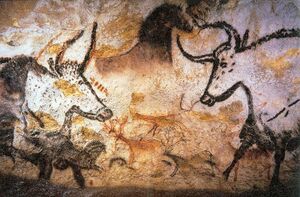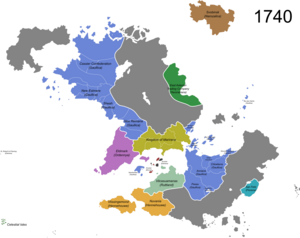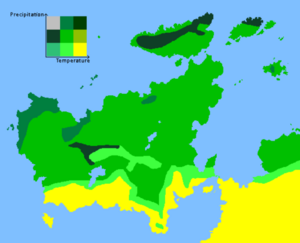Euclea: Difference between revisions
| Line 43: | Line 43: | ||
===Classical antiquity=== | ===Classical antiquity=== | ||
[[File:Piraean_colonization_classical_period.PNG|thumb|Peak extent of Piraean territories and colonies from 750 | [[File:Piraean_colonization_classical_period.PNG|thumb|Peak extent of Piraean territories and colonies from 750 to 200 BC]] | ||
The Classical Age in Euclea began in the 8th century BC, when | The Classical Age in Euclea began in the 8th century BC, when city-states were established in [[Piraea]], consolidating political power. This era is considered formative in the development of {{wp|democracy}} and {{wp|political culture}}. The first democracy was established in the city-state of [[Lasithi]], where all adult male citizens were permitted to vote in the {{wp|Ecclesia (ancient Greece)|Assembly}}. Furthermore, this period in Piraean history was formative in the foundation of {{wp|philosophy}}, {{wp|humanism}}, {{wp|historiography}}, {{wp|epic poetry}} and {{wp|drama|dramatic theater}}, all of which trace their origins to Piraean authors. Furthermore, Piraean authors were among the first to document {{wp|astronomy|the stars}} and {{wp|medicine}}. Piraea also saw extensive political expansion. Lasithi emerged as a {{wp|hegemon}}, presiding over the expansion of Piraean territory from Gaullica to [[Satria]] in [[Coius]]. At the same time, this period saw great infighting among the Piraean city-states. Extensive civil wars and feuding tore apart Piraean cities and relocated power among various city-states. The collapse of [[Prassa|Prassan]] hegemony in 217 BC marked the end of a cohesive Piraea. | ||
In the wake of Piraea, Solaria rose, continuing or altering many of Piraea's age-old traditions. [[Solaria]] was founded in 757 BC, originally as a {{wp|monarchy}}. Inspired Piraean democracy, the Solarians overthrew their monarchical system and established an {{wp|oligarchy|oligarchic}} {{wp|republic}} in 511 BC. Contemporaneously with the rise of Solaria, the ancient city-state of Tyrrenhus rapidly grew in size. Solaria and Tyrrenheus were soon at loggerheads and fought numerous wars against each other. This period of aggression, known as the [[Wars of the Two Cities]], ended in Solarian victory and the subjugation of Tyrrhenius in 256 BC. Solaria became the dominant power of of the [[Aurean Straits|Aurean region]], though it often came under the sack of {{wp|Celts|Tenics}}. By 200 BC, Solaria expanded across Southern Euclea and forayed into Gaullica. | In the wake of Piraea, Solaria rose, continuing or altering many of Piraea's age-old traditions. [[Solaria]] was founded in 757 BC, originally as a {{wp|monarchy}}. Inspired Piraean democracy, the Solarians overthrew their monarchical system and established an {{wp|oligarchy|oligarchic}} {{wp|republic}} in 511 BC. Contemporaneously with the rise of Solaria, the ancient city-state of Tyrrenhus rapidly grew in size. Solaria and Tyrrenheus were soon at loggerheads and fought numerous wars against each other. This period of aggression, known as the [[Wars of the Two Cities]], ended in Solarian victory and the subjugation of Tyrrhenius in 256 BC. Solaria became the dominant power of of the [[Aurean Straits|Aurean region]], though it often came under the sack of {{wp|Celts|Tenics}}. By 200 BC, Solaria expanded across Southern Euclea and forayed into Gaullica. | ||
Revision as of 06:14, 18 February 2023
Template:Region icon Kylaris Template:KylarisRecognitionArticle
| Euclea | |
|---|---|
 | |
| Area | 9,511,739 km² |
| Population | Template:Euclea-pop |
| Density | 77 people per km² |
| GDP (nominal, millions) | $22,469,614 |
| GDP per capita | $30,800 |
| Time zones | UTC +2 to –4 |
Euclea is a continent located entirely in the Northern and Western Hemispheres of Kylaris. It is bordered to the north by the Pervovo Sea, Avanaric Sea, and Boreal Ocean, to the northeast by the Ghaillish Sea and North Sea, to the east by the Florian Ocean and Gulf of Assonaire, to the south by the Solarian Sea and Acheloian Sea, and to the west by the Lumine Ocean. Coius lies to the south and east.
Euclea covers approximately one sixteenth of Kylaris's surface and is home to slightly over one fifth of its population. It is the world's second-most populous continent after Coius and is its richest on a gross GDP basis; nearly 40% of the world's aggregate GDP is generated in Euclea. Politically, Euclea is divided into approximately thirty states, twelve of which comprise the Euclean Community. Soravia is the largest and most populous country in Euclea.
Etymology
The name Euclea comes from the ancient Piraean goddess Eukleia (Ευκλεια), the deity personifying glory and good repute.
History
Prehistory
Various species of hominids lived in Euclea as early as 1.3 million years ago. The oldest attested Euclean inhabitants that belonged to the genus Homo is the archaic Homo antecessor, whose fossils have been found in Carvagna, Etruria and other sites around the Solarian Sea. Homo erectus migrated into Euclea from Rahelia or Bahia. Sometime around 150,000 BC, Homo neanderthalensis (Neanderthals) appeared around Cislania in Werania. The Neanderthals disapeared sometime around 28,000 BC. Contemporaneously, the first anatomically modern humans emerged on the Euclean continent around 35,000 BC. These first humans also migrated from Coius and supplanted the Neanderthals. DNA evidence suggests that early Euclean humans may have interbred with the Neaderthals as well as other hominids. The earliest habitations of early Euclean humans are recorded around Palestrina (Etruria), Llerta (Paretia) and Monroial (Gaullica). These first people were hunter-gatherers and nomads reliant on stone tools. Humans spread across Euclea and reached the western parts of Soravia by 10,000 BC.

The Neolithic Revolution began in Euclea around the 8th millennium BC in Piraea and Etruria, prompted by the spread of agriculture spread from Coius. During this time, many of Euclea's hunter-gatherer peoples became sedentary. Their lifestyles revolved around sowing and reaping crops as well as rearing domesticated animals. Around this time, Eucleans developed early social stratification and produced pottery. Large caches of Neolithic pottery dating to as late as 7000 BC has been found in Werania and Azmara. This period also saw the development of primitive shipbuilding, which enabled the settlement of the Line Islands around 6500 BC. Early Eucleans also built burial mounds (also known as kurgans) and megaliths like dolmens.
The 5th century BC saw the migration of various peoples. The Satro-Euclean peoples migrated into Euclea around 4000 BC and supplanted many indigenous peoples. Finno-Ugric peoples migrated into Caldia around 3300 BC. They would later be supplanted by the Satro-Euclean Tenics around 1000 BC. The last major expansion of prehistoric Euclean peoples occurred in 1500 BC, when humans made landfall on the Geatish Islands.
Around 3200 BC, bronze tools were spread from Coius to Euclea, beginning the Euclean bronze Age. The Euclean Bronze Age saw the rise of the Esorian civilization on the island of Emessa, described as the first true civilization in Euclean history. The Esorians developed an extensive trade network that linked Coius with Euclea. Traders made treacherous journeys as far north as the tin mines of present-day Werania to acquire the precious metal. The Esorians developed a still-undeciphered writing system, a sui generis syllabary that was the first documented in Euclea. In Piraea, the Mycenaean civilization developed as an important trade route to Western Euclea. Southern Euclea saw social stratification comparable with that of the Ancient Near East, characterized by the development of primitive kingdoms with tribal, warrior, merchant and peasant castes. The Bronze Age of development and prosperity ended suddenly when mysterious seafaring peoples attacked various Aurean civilizations. The resultant collapse led to the Piraean Dark Ages and the cessation of international trade.
Classical antiquity
The Classical Age in Euclea began in the 8th century BC, when city-states were established in Piraea, consolidating political power. This era is considered formative in the development of democracy and political culture. The first democracy was established in the city-state of Lasithi, where all adult male citizens were permitted to vote in the Assembly. Furthermore, this period in Piraean history was formative in the foundation of philosophy, humanism, historiography, epic poetry and dramatic theater, all of which trace their origins to Piraean authors. Furthermore, Piraean authors were among the first to document the stars and medicine. Piraea also saw extensive political expansion. Lasithi emerged as a hegemon, presiding over the expansion of Piraean territory from Gaullica to Satria in Coius. At the same time, this period saw great infighting among the Piraean city-states. Extensive civil wars and feuding tore apart Piraean cities and relocated power among various city-states. The collapse of Prassan hegemony in 217 BC marked the end of a cohesive Piraea.
In the wake of Piraea, Solaria rose, continuing or altering many of Piraea's age-old traditions. Solaria was founded in 757 BC, originally as a monarchy. Inspired Piraean democracy, the Solarians overthrew their monarchical system and established an oligarchic republic in 511 BC. Contemporaneously with the rise of Solaria, the ancient city-state of Tyrrenhus rapidly grew in size. Solaria and Tyrrenheus were soon at loggerheads and fought numerous wars against each other. This period of aggression, known as the Wars of the Two Cities, ended in Solarian victory and the subjugation of Tyrrhenius in 256 BC. Solaria became the dominant power of of the Aurean region, though it often came under the sack of Tenics. By 200 BC, Solaria expanded across Southern Euclea and forayed into Gaullica.

The Solarian Republic came to an end in the first century AD, when power was consolidated in the lands of the first Solarian emperor. In the Pax Solariana, Solaria then embarked on expansion heretofore never seen in the world, blazing a trail through Estmere and Swetania in the north and modern-day Zorasan in the south. The Solarian Empire established a complex, intracite system of bureaucratic government and centralization. Neighboring tribes such as the Tenics or the Marolevs were conquered, displaced and integrated into the empire. By 318, Solaria became the largest empire in Euclean history. The empire's advanced road systems enabled for the spread of Sotirianity. A persecuted religion for most of its early history, Sotirianity gained prominence among the lower classes of Solaria. Persecution of Sotirians was lessened dramatically when Emperor Honorious declared the faith the official religion of Sotiria, sidelining the tradiitonal Solarian polytheistic religion. The Solarian Catholic Church consolidated Sotirian literature and dogma.
Weranic tribes, one of many displaced peoples in Solarian territory, began to menace Solarian authority These tribes were particularly troublesome in Solarian Gaullica. Economic troubles, overreliance on slave labor and government corruption had critically weakened the Sotirian Empire. Furthermore, the eruption of Mount Vecuvia led to the destruction of much of Solaria, the jewel in the empire's crown, in AD 395. The Heavenly Dominions rode roughshod over Solaria's territory in North Coius, while Weranic tribes threatened Solaria to the north. These events culminated in the collapse of the Solarian Empire by 424. In its over thousand years of existance, Solaria was crucial in the foundation of law, architecture, and engineering (particularly hydraulics). The language of Solaria, Latin is the ancestor of many of Euclea's most prominent languages, such as Gaullican or Etrurian.
Middle Ages
The collapse of the Solarian Empire left a power vacuum in Southern Euclea, which led to the rise of the Verliquoian Empire, centered in Verlois. Led by Claude Gaullica, the empire first pursued conquest in its north, capturing Estmere and Hennehouwe. The Last Solarian Expidition was the empire's greatest expansion, during which Gaullican generals like Tacitus de la Croix conquered the coast of Etruria much of modern-day Tsabara. The campaigns ended in AD 524 and expanded the empire to its height. By that time, various vassals of the empire had been established as far north as modern-day Kirenia. Successive emperors had trouble maintaining their lands and supressing internal rebellion and was often poorly administered. By the 8th century, the empire had decentralized and saw the rise of feudalism. In the meanwhile, Great Vesemir was established as a loose confederation of Marolev principalities; it would collapse in 910.
Decentralization in the Verliquoian Empire's Coian territories led the First Heavenly Dominion. The Tagamic hords commanded by Chanyu Ekkin rolled into and captured most of Verliquoian territory in Coius and mounted an invasion of the the empire's Euclean heartland. In 876, two Tagamic hordes landed in Paretia. The horde rapidly advanced into Euclea, tearing through cities and destabilizing South Euclea. The horde was met with feeble resistance at first and overwhelmed most Euclean armies in its path. The hords was graudally repulsed by the armies of Emperor Philippe II and Saint Chloé in 884, though Euclea would face recurrant skirmishes with Tagamics until the 11th century. The Tagamic invasion weakened the empire, though it was able to wage a successful campaign against the Empire of Arciluco, which also claimed to be a successor to Solaria, in 891. The Empire of Arciluco collapsed in 1000.

In North Euclea, Ghailles from Caldia known as Marauders or Lochlananch began a period of widespread raiding and conquest starting from 8th century and ending in the 11th century AD. These raiders, who had been motivated by sundry factors, birthed the Maurader Age of Euclean history and conquered lands in Borland, Estmere, Geatland, Solstiana, and Werania. In addition, there are records of Ghaillish pirates travelling as far south as Rahelia. The Marauders precipitated various political changes in North Euclea, and they were overrrun in many of the places they established a foothold. The First North Sea Empire was formed in 847 and frequently clashed with the raiders. In modern-day Geatland, Gorm the Elder united the Ancient Geatish tribes against the raiders in 944. The Kingdom of Embria, the predecessor state to Estmere, was establisehd in the 11th century. This mass movement of peoples expanded Sotirianity to Euclea's northern reaches. Almost all of Euclea practiced Sotirianity by the 14th century.
The later periods of the Middle Ages was characterized by the growing and expanding influence of the Sotirian Catholic Church, as well as its clashes with the Episemialist Church, culminating in a schism in the year 1385. The rise of Iconoclasm in Western Eculea would also see the outbreak of the Iconoclast Wars in 1408. This period also saw clashes between Euclean Sotirians and Irfan, the most prevalent of these clashes being the War of the Crescent and the Cross. The Medieval Warm Period allowed for greater crop yields that resulted in a population boom on Euclea. Feudalism and manorialism were the two most prevalent economic systems, and society was structured along a rigid heirarchy separating nobility from the peasantry. The system of knighthood was created, whereby knights would swear fealty of arms to a monarch or other ruler in exchange of lands. Consequently, this period saw many clashes between feuding lords eager to snatch up land and expand their wealth. Although this period has been stereotyped as a dark age in historiography and folk history, it saw many advances in theology, poetry, and philosophy. Montecara and other surrounding islands grew very wealthy off of trade between Euclea and Coius, much of which involved the importation and sale of slaves from the latter. Excess wealth from commerce was used to patronize authors, musicians artisans and painters as well as many architectural works.
Early modern period
In 1488, a Caldish expiditionary force led by Assim Asteris discovered the Asterias for Eucleans. This "Age of Discovery" and Euclean exploration in the Asterias prompted the widespread transfer of plants , crops and animals between Euclea and the newly-found territories. These exchanges, which also brought Euclean diseases to the Asterias, grew Euclean trade and brought great wealth to the continent that marked the beginning of modernity. Contemporaneously with the discovery and exploitation of the Asterias, Etruria experienced a renaissance of new art styles, literature, architecture, and philosophy. The knowledge of classical Piraean texts, which had previously been lost, was revived and led to the development of humanism. This period also marked the expansion of large multinational empires in Euclea, such as the Soravian Empire founded in 1567 or the Gaullican Empire which began consolidating within central eastern Euclea. During this period, various Euclean powers established colonial administrations on the Asterias and trafficed Bahian slaves into the continent in the Transvehemens slave trade. The 16th century saw a reckoning with traditional religious thought in East Euclea when Amendism was formed as a protest move against the Solarian Catholic Church. Religious conflicts and violence culminated in the Amendist Wars from 1582 to 1607. The war guaranteed Amendists religious freedoms and territories of their own but led to the decline of previously cohesive Solarian Catholic entities such as the Rudolphine Confederation.
Euclean colonial possessions in the Asterias became concentrated around imperial Gaullica. Disagreements over colonial and territorial possessions bred many wars between various Euclean nations during a drawn-out period of crisis, most prominently the Ten Years' War between 1711 and 1721. In 1737, the Estmerish Civil War ended in 1737, establishing a constitutional monarchy and the rise of liberalism. This period coincided with the Age of Enlightenment, which placed value on reason, empiricism and the scientific method. Discontent between the colonists and the home countries culminated in the Asterian War of Secession, which saw many states in Asteria Superior and Inferior declare and win their independence from various Euclean powers by the end of the 18th century. The loss of Euclean colonies in the Asterias ended the merchantist model and led to the rise of capitalist economies. The industrialization of Euclea in the 18th and 19th centuries transformed most of Euclea's nations from agrarian societies to those based on manufacturing. The industrialization of Euclea saw the development of machine technology and the rapid advance of technological innovation.
Modern period
Industrialization and the liberalization of wealth precipated profound social, political and technological changes. The 1783 Rayenne Revolution started a chain of events that led to concurrent successful republican revolutions in modern day Etruria (the latter unifying for the first time) and Werania that started the Euclean Revolution Wars. Whilst the defeat of the Etrurian First Republic in 1810 saw the defeat of radical republican forces, it had started the Euclean Spring which saw a general trend towards the creation of the nation-state over multinational empires, democratisation and the beginning of the end of political absolutism. The spring was motivated by liberalism and nationalism, being most dramatically expressed during Weranian Unification. Weranian unification in turn led to the War of the Triple Alliance which saw a realignment in the balance of power in Euclea away from Gaullica-Kirenia towards Werania-Estmere. The war also directly led to the First Soravian Civil War from 1857 to 1861 which resulted in the abolition of the Soravian monarchy and the creation of modern Soravia under Eduard Olsov. Some scholars say that Euclean Spring ended after the Green Revolution was defeated in 1868, although some persist it continued onto the Vallmo Revolt of 1887 or the abolition of the Etrurian monarchy in 1888.

These events alongside the development of industrial capitalism facilitated a new wave of imperialism. Euclean colonies were established in Coius during the Scramble for Coius primarily in Bahia and Southeast Coius. In 1813, Baséland was created as a protectorate of Gaullica. Colonialism in Bahia and Rahelia established the Toubacterie, which was often met by unsuccessful resistance from the indigenous peoples. The new political landscape involved a tenuous balance of power between Gaullica, Estmere, Werania, Etruria, and Soravia. This balance of power was significantly upset both internally and externally following the Great Collapse in 1913. The rise of functionalism in Gaullica under Rafael Duclerque and the socialist April Revolution in Kirenia as well as massive shifts in geopolitical headwinds culminated in the Great War starting in 1927. The war pitted the Grand Alliance against the Gaullican-led Entente. It was the deadliest in the history of the world and saw the innovation of new military technologies and strategies, such as chemical weapons, trench warfare, tank warfare and aerial warfare. Despite early successes by the Entente most notably the total defeat of Estmere early during the war eventually Entente forces in Euclea were defeated with Gaullica surrendering in 1934.
The defeat of Gaullica ended its position as a superpower globally with the dismantling of its empire, but divisions within the Grand Alliance quickly saw its members fracture post-war into a system of mutual rivalries. The Great War destroyed much of Euclea's industry and killed millions of its people. In response to the violence, various supranational organizations were established in Euclea, most notably the United Nations of Euclea in 1936. The Great War also resulted in the abolition of the Estmerish and Gaullican monarchies with the latter ungoing intense de-functionalisation and a transition into a liberal democracy whilst Etruria embraced neo-functionalism with the creation of the Etrurian Revolutionary Republic. Post-war tensions led to the partition of Miersa into East and West under the Godfredson Plan in 1936. Despite attempts at maintaining peace, a local conflict between Etruria and Piraea ballooned into the Solarian War from 1943 to 1946. Etruria's invasion of various colonial territories and a genocide against ethnic Piraeans resulted in Community of Nations intervention against it that hastened its defeat. The Kirenian-Weranian War from 1949 to 1950 was the last war in Euclea fought between great powers when Weranian forces were decisively defeated by their Kirenian counterparts. The aftermath of the Solarian War combined with the economic recovery of Gaullica saw the formation of Euclean Community that replaced the moribund UNE, with the EC orchestrating economic recovery and the establishment of the postwar consensus.

The 1940s and 50s were marked by a wave of Pan-Bahist and other anti-colonialist movements that demanded home rule. This resulted in the delonization of Bahia and Southeast Coius - this process was sometimes peaceful as was mostly the case for Estmerish colonies whilst others such as Weranian and Etrurian colonies often saw more violence. Scientific advancement led to the creation of the nuclear bomb by Kirenia in the early 1950's, whose proliferation was curbed by the Treaty of Shanbally in 1965. For the second half of the 20th century northerneast Euclea remained largely democratic whilst southern and western Euclea were authoritarian.
A civil war in Soravia known as the Sostava War that lasted from 1979 to 1983 resulted in the collapse of the previous Soravian government and the emergence of several new states such as Radushia, Vedmed and Velzemia as well as the 1979-1982 Miersan War. The same period saw the fall of several authoritarian regimes primarily in south Euclea such as in Etruria Amathia, Piraea and Slirnia. Many Euclean nations restructered their economies following the 1980 recession, one consequence of which was the rise of globalism. Soravia loosened its control over its former territories and established Samorspi whilst socialist states in northern Euclea created the Mutual Assistance Organisation in 1999. Meanwhile, the Euclean community established its parliament in 1964, a common monetary system in 1983 and directly-elected president in 2007. The 2005 financial crisis heavily affected the EC, whose status as the most preeminent geopolitical organisation has been questioned due to the continued rise of Coian and Asterian nations and consolidation of organisations such as Samorspi and MAO.
Geography
The Euclean climate is affected by warm currents that temper winters and summers for most of the continent, even at latitudes along which the climate elsewhere is severe. Seasonal differences are more noticeable farther inland than close to the coast.
Politics
Euclea is home to a number of regional organizations, most prominently the Euclean Community, which is currently the world's most fully realized supranational organization. Its member states have agreed to the free movement of goods, people, capital, and services, and have adopted a common currency, the euclo. Other major regional organizations include Samorspi, which brings together states that once comprised the Soravian Empire, the Mutual Assiestence Organisation which consists of the socialist states of northeast Euclea, the Aurean Forum, and the Northern Forum. The Community of Nations is headquartered in the Euclean country of Kesselbourg.
List of states and territories
| Name | Capital | Population | Area (km²) | Head of State | Head of Government | Government type |
|---|---|---|---|---|---|---|
| 11,384,499 | 46,789 | Reedik Kaljurand | Ottila Möller | Semi-presidential republic | ||
| 6,708,921 | 100,000 | Kabentim Teguzboded | Manham Batsatindim | Parliamentary republic | ||
| 35,852,332 | Area | Presidency of Amathia | Ramona Veleșean | Semi-presidential republic | ||
| 10,029,100 | 43,018 | Harald Alekssun | Sofija Anasdohter | Parliamentary republic | ||
| 10,422,100 | 171,288 | Viktor Kríž | Martina Ovoječka | Semi-presidential republic | ||
| 9,257,180 | 315,093 | Kenneth IV | Stiofán Mac Suibhne | Parliamentary constitutional monarchy | ||
| 21,740,000 | 197,568 | Anna Wlodarska | Council republic | |||
| 6,192,106 | 90,819 | Brunhild | Karl Nilsson Jung | Parliamentary constitutional monarchy | ||
| 5,681,900 | 22,487 | Lisandrina Orunesu | Xandru Grixti | Parliamentary republic | ||
| Template:Country data Estmere | 56,519,373 | 284,874 | Alice Roberts | Zoe Halivar | Parliamentary republic | |
| 65,596,083 | 909,388 | Parliamentary republic | ||||
| 87,176,289 | 1,149,240 | Monique Degar-Abdulrashid | Mathéo Turzyna | Semi-presidential republic | ||
| 11,424,398 | 75,828 | Adriaan Wilhelm Paulus | Rupert van Bleiswijk | Parliamentary republic | ||
| 1,424,500 | 8,000 | William II | Emmanuel Schmit | Parliamentary constitutional monarchy | ||
| 2,502,577 | 41,834 | Presidency | Sergiusz Galecki | Parliamentary republic | ||
| 1,801,328 | 1145.43 | Directorial republic | ||||
| 31,203,301 | 240,886 | Erasmo | Isilda Cerqueira | Parliamentary constitutional monarchy | ||
| 13,284,889 | Area | Pavlos Kassapidis | Maria Theopeftatou | Parliamentary republic | ||
| 4,193,694 | 8,646 | Macarius II | Raman Yarmoshyn | Parliamentary constitutional theocracy | ||
| 27,003,197 | 884,477 | Henrik | Ine-Linda Nesby | Parliamentary constitutional monarchy | ||
| 88,081,653 | 2,985,973 | Valentina Goga | Nicolai Karpenko | Semi-presidential republic | ||
| 22,350,000 | 305,981 | Teodora Kovacheva | Presidential republic | |||
| 55,279,300 | 423,489 | Presidium | Janis Vilks | Council republic | ||
| 10,578,243 | 149,023 | Erekle Botkoveli | Parliamentary republic | |||
| 58,579,684 | Area | Charlotte | Anton Raicevich | Parliamentary constitutional monarchy | ||
| 16,419,000 | 203,965 | Stanisław Kantorowicz | Authoritarian republic | |||
Culture

Notes
- ↑ Emessa can be considered part of Rahelia or Southern Euclea; it has historical and sociopolitical connections with both.


